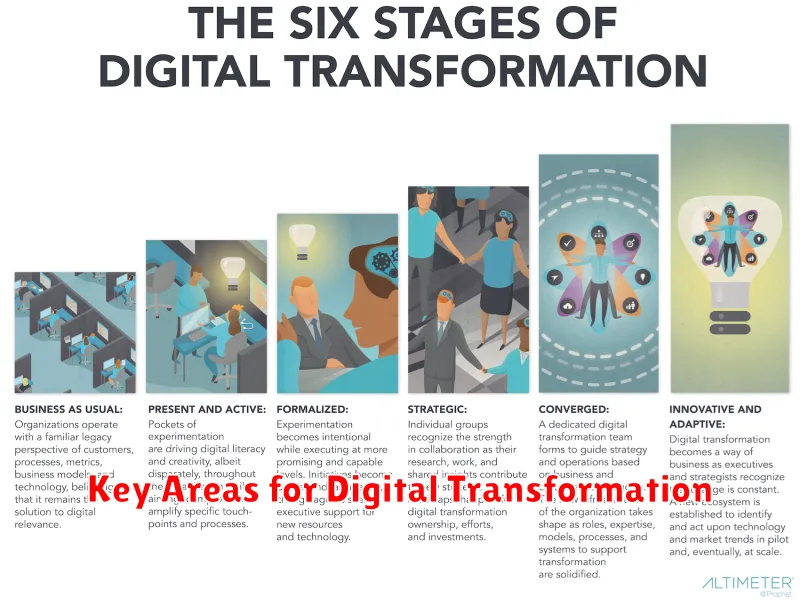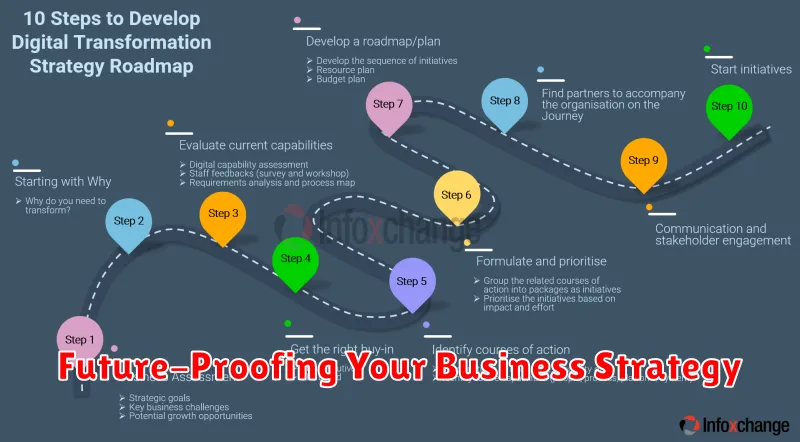In today’s rapidly evolving digital landscape, a digital transformation strategy is no longer a luxury but a necessity for every business, regardless of size or industry. Embracing digital transformation allows businesses to optimize operations, enhance customer experiences, and drive innovation. Without a robust digital transformation strategy, businesses risk falling behind competitors, losing market share, and ultimately, becoming obsolete. This article will explore why a digital transformation strategy is crucial for every business in the modern era, and how it can unlock unprecedented opportunities for growth and success.
A well-defined digital transformation strategy provides a roadmap for businesses to effectively integrate digital technologies into all aspects of their operations. From streamlining internal processes and improving communication to enhancing customer engagement and creating new revenue streams, a digital transformation strategy enables businesses to leverage the power of digital tools and data analytics to achieve their strategic objectives. This proactive approach to digital transformation is essential for businesses looking to thrive in the competitive digital economy and ensure long-term sustainability.
What Is Digital Transformation?
Digital transformation is the integration of digital technology into all areas of a business, fundamentally changing how you operate and deliver value to customers. It’s also about cultural change that requires organizations to continually challenge the status quo, experiment, and get comfortable with failure.
It’s not just about adopting new technologies, but about reimagining business processes, creating new business models, and fostering a culture of innovation.
Assessing Your Digital Readiness
Before embarking on a digital transformation journey, it is crucial to assess your current digital maturity. This involves evaluating your organization’s existing technology, processes, and culture.
A thorough assessment identifies strengths and weaknesses, providing a baseline for measuring progress. Key areas to evaluate include:
- Customer Experience: How effectively do you engage with customers digitally?
- Operational Processes: Are your operations optimized through automation and data analysis?
- Technology Infrastructure: Is your technology modern, scalable, and secure?
- Employee Skills: Do your employees possess the necessary digital skills?
Understanding these areas helps define the scope of your digital transformation and prioritize areas for improvement.
Key Areas for Digital Transformation

Digital transformation impacts all facets of a business. However, focusing on key areas maximizes impact and ensures efficient resource allocation. These key areas typically encompass several core business functions.
Customer Experience: Enhancing how customers interact with the business through digital channels is crucial. This includes improving online presence, personalizing interactions, and providing seamless omnichannel experiences.
Operational Processes: Streamlining operations through automation and data-driven insights leads to increased efficiency and reduced costs. This can involve automating workflows, implementing intelligent systems, and leveraging data analytics for better decision making.
Business Models: Digital transformation can fundamentally change how a business operates and generates revenue. This might involve developing new digital products or services, exploring subscription models, or leveraging platform-based ecosystems.
How Technology Improves Customer Experience
Technology plays a crucial role in enhancing customer experience. Personalized experiences are now possible through data analysis, allowing businesses to tailor offers and services to individual customer needs. This leads to increased customer satisfaction and loyalty.
Automation streamlines processes, reducing wait times and improving efficiency. Customers can access information and services quickly and easily, 24/7. This convenience factor is a major driver of positive customer experience.
Improved communication channels, such as chatbots and social media integration, provide multiple avenues for customers to interact with businesses. This omnichannel approach ensures that customers can reach out on their preferred platform, fostering stronger relationships.
Streamlining Operations with Digital Tools
Digital tools offer significant opportunities to streamline business operations, boosting both efficiency and productivity. Automation plays a key role, handling repetitive tasks and freeing up human capital for more strategic initiatives.
Data analytics tools provide valuable insights into operational performance, identifying bottlenecks and areas for improvement. This data-driven approach empowers businesses to make informed decisions and optimize processes for maximum impact.
Furthermore, digital communication platforms enhance collaboration and workflow management. These tools facilitate seamless information sharing and project tracking, leading to improved coordination and faster turnaround times.
Integrating Cloud and Mobile Solutions
A core component of digital transformation involves integrating cloud and mobile solutions. Cloud computing provides scalable and cost-effective infrastructure for data storage, processing, and software delivery. This allows businesses to access resources on demand and eliminates the need for significant upfront investment in hardware.
Mobile solutions extend business processes and services to employees and customers regardless of location. Integrating mobile apps with cloud backends enables real-time data synchronization, enhanced communication, and improved customer engagement. This combination empowers a truly agile and connected workforce.
Common Digital Transformation Pitfalls
Embarking on a digital transformation is a complex undertaking. Many organizations encounter obstacles that hinder their success. Avoiding these common pitfalls is crucial for maximizing return on investment and achieving desired outcomes.
Lack of Clear Vision: Transformations often fail without a well-defined vision and strategy. Clearly outlining objectives, scope, and key performance indicators is essential.
Insufficient Executive Sponsorship: Strong leadership and commitment from the top are vital. Without executive buy-in and active participation, initiatives can lose momentum.
Resistance to Change: Cultural resistance to adopting new technologies and processes can impede progress. Addressing concerns and fostering a culture of innovation are key.
Ignoring Customer Experience: Digital transformations should ultimately improve the customer experience. Failing to prioritize customer needs can lead to ineffective solutions.
Measuring Digital Transformation Success
Measuring the success of digital transformation initiatives requires a multi-faceted approach, focusing on both tangible and intangible benefits.
Key Performance Indicators (KPIs) should be aligned with strategic objectives. These might include improvements in customer satisfaction, increases in operational efficiency, reductions in costs, or growth in revenue.
Beyond financial metrics, consider measuring the impact on employee productivity, innovation, and organizational agility.
Case Studies: Successful Transformations
Examining real-world examples illustrates the positive impact of digital transformation. One example is a traditional retailer that integrated e-commerce into its operations. This allowed them to reach a wider customer base and significantly increase sales.
Another case study involves a manufacturing company that implemented automation and data analytics. This led to improved efficiency, reduced operational costs, and enhanced product quality. These successful transformations highlight the tangible benefits businesses can achieve through strategic digital initiatives.
Future-Proofing Your Business Strategy

In today’s rapidly evolving digital landscape, future-proofing your business strategy is no longer a luxury, but a necessity. A robust digital transformation strategy helps businesses navigate uncertainty and capitalize on emerging opportunities.
This involves understanding key technological trends, such as artificial intelligence, cloud computing, and the Internet of Things, and integrating them strategically into your operations. It requires a shift in mindset, embracing agility and data-driven decision-making.
By proactively adapting to technological advancements and changing customer behaviors, businesses can mitigate risks, enhance operational efficiency, and maintain a competitive edge in the long term. This forward-thinking approach ensures sustainable growth and relevance in the face of future disruptions.

